
The Best Decoy Spreads to Land More Ducks
As ducks migrate from North to South, they can be heavily pressured by hunters along the way. Understanding their behavioral instincts is crucial to strategizing how to setup your next decoy spread for duck hunting.
Here are a couple decoy spread tips or "general rules of thumb" to keep in mind no matter how pressured the ducks you're hunting are:
- Setup with the wind to your back, ducks and geese approach their landing by flying into the wind. If you can't do wind to your back, then worst case scenario is a cross wind.
- Leave an open space for the ducks to land, and plan this area accordingly to give you the best shot opportunity.
- If you use motorized decoys, position them so the sun shines directly on their wings. Similar to a shiny lure attracting fish, the glimmer can bring more attention to your decoy spread. Keep in mind the sun rises in the east and sets in the west.
- Keep your spread tight (each decoy should stay within 4-5 feet of another) to minimize the risk of incoming ducks landing within your decoys and not in the target landing zone.
- Face your decoys into the wind, even if it's a light wind. This is naturally how ducks position themselves and helps aid in the realism of your setup.
- Get to your spot early and minimize the effect you have on your environment. Traveling in the dark can be difficult, so dress your boat with quality duck hunting lights accordingly. The DURANAV® Duck Boat Lights are second to none for duck hunting.
- Evenly mix drakes and hens. Drakes are more eye-catching but too many drakes in one spot can appear unnatural.
- Choose the right decoys for your environment. Here's a good article to learn more about the proper decoy selection.
There are two general types of ducks: those that are highly pressured and lightly pressured. You can typically get an idea for which duck you're going to be hunting based upon whether you're hunting private land or public land and how accessible the area your hunting is.
If it's early in the season, the ducks are likely to be lightly pressured. If it's mid to late season, they are likely more heavily pressured and have become more educated to decoy formations.
An early season decoy spread typically won't work well for heavily pressured ducks and a late season decoy spread typically won't work as well for lightly pressured ducks. The reason being is ducks are very shy late in the season and less likely to land near decoy spreads while they are not as shy early in the season and more likely to land within or next to decoy spreads.
Types of Decoy Spreads for Lightly Pressured Ducks
Types of Decoy Spreads for Highly Pressured Ducks
J Hook "Fish Hook" Decoy Spread
Gapped J Hook "Fish Hook" Decoy Spread
The Wary Duck Side Decoy Spread
The Wary Duck Split Decoy Spread
Let's dive into each decoy spread and figure out which one will work best for you to bring more success to your next duck hunting trip.
Types of Decoy Spreads for Lightly Pressured Ducks
These types of decoy spreads are ideal for early season hunting and hunting in areas where ducks aren't as pressured from hunters. This includes more secluded public land or private land.
Wide Angle V Spread
The Wide Angle V decoy spread is similar to the split spread, but you'll start your decoys literally right in front of you and then fan them out to each side roughly 30-40 yards out.
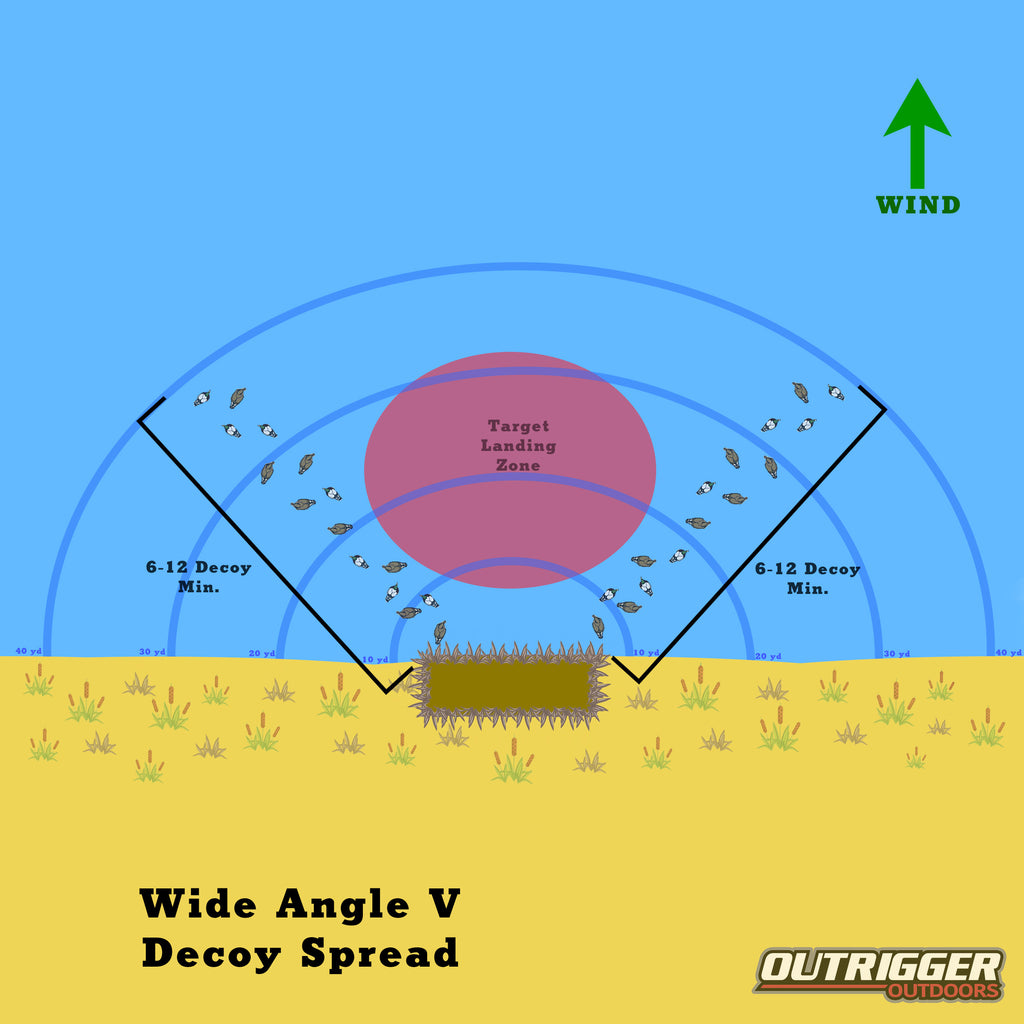
This spread typically requires a minimum of 24 decoys, with 12 set up on the left side and another 12 set up on the right side.
If you have a cross wind, we recommend setting up the wide angle V decoy spread according to the wind direction. The open side of the "V" should always be opening with the wind. Traveling ducks will land against the wind and the idea is to have them land in the opening of the "V". This formation is very effective with cross winds, as long as it is set up as we discussed.
Split Decoy Spread
The split decoy spread is exactly what it sounds like - half your decoys are set up 10-15 yards to the left of you and the other half are 10-15 yards to the right of you. The goal here is to entice incoming ducks to land right in the middle, in the 20-30 yard gap you have created, making for an easy shot.

This spread requires at least 12 decoys, split 6 and 6 on each side. If your budget allows, you might find more success bumping your decoys up to 24 or 36 and evenly splitting them.
3 Way Decoy Split
The 3 way split decoy spread is the same as the split decoy spread we discussed above but this time we are putting an additional 6 decoys right in-front of where we, the duck hunter, are setting up.
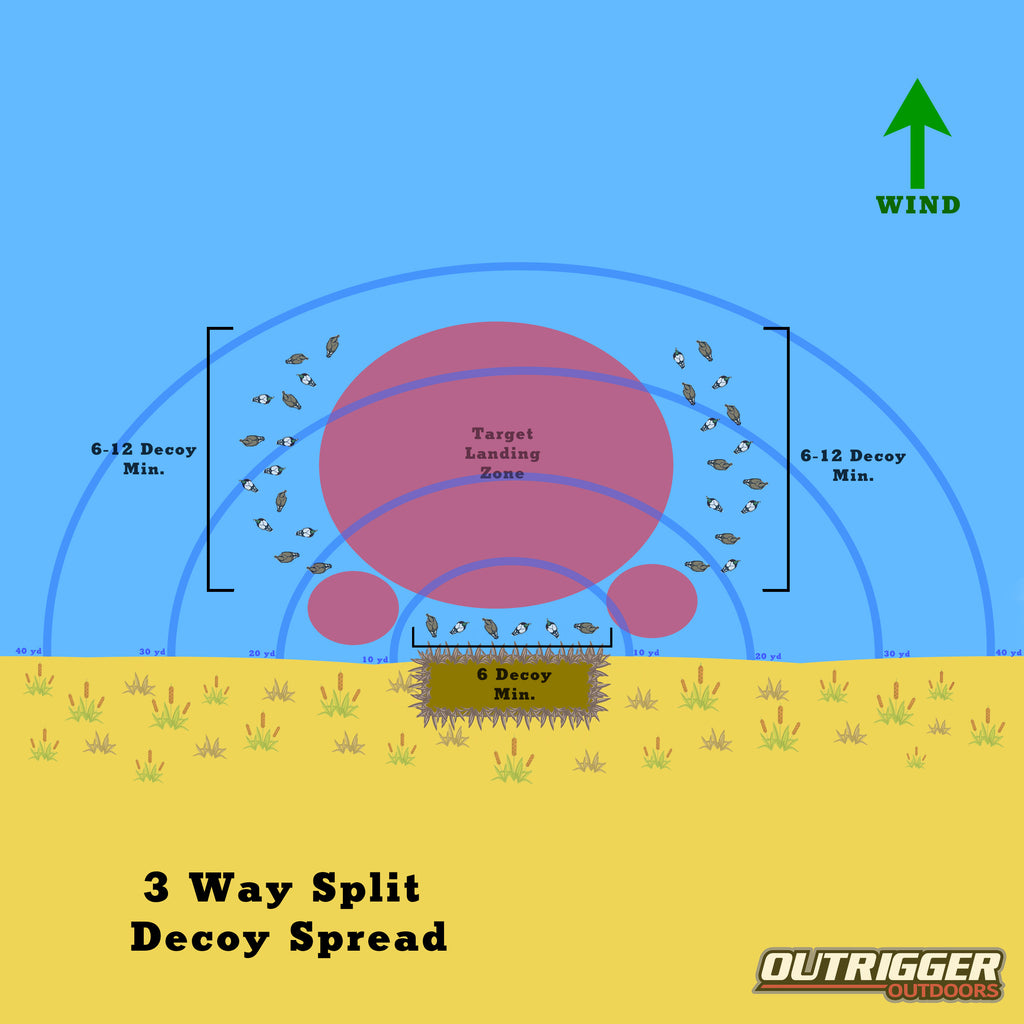
Open Circle Decoy Spread
The open circle decoy spread is ideal for light wind days or even tighter spaces such as small rivers or ponds. The goal here is to align you're decoys on the edge of the target landing zone, spread around in a large circle. The side opposite of where you setup your duck blind should have a 10 yard opening which invites incoming ducks to land in the open "target zone".
Mixing 1-3 decoys in the center of the target zone can be more inviting. Ideally you want 1 drake and 1-2 hens in the center.
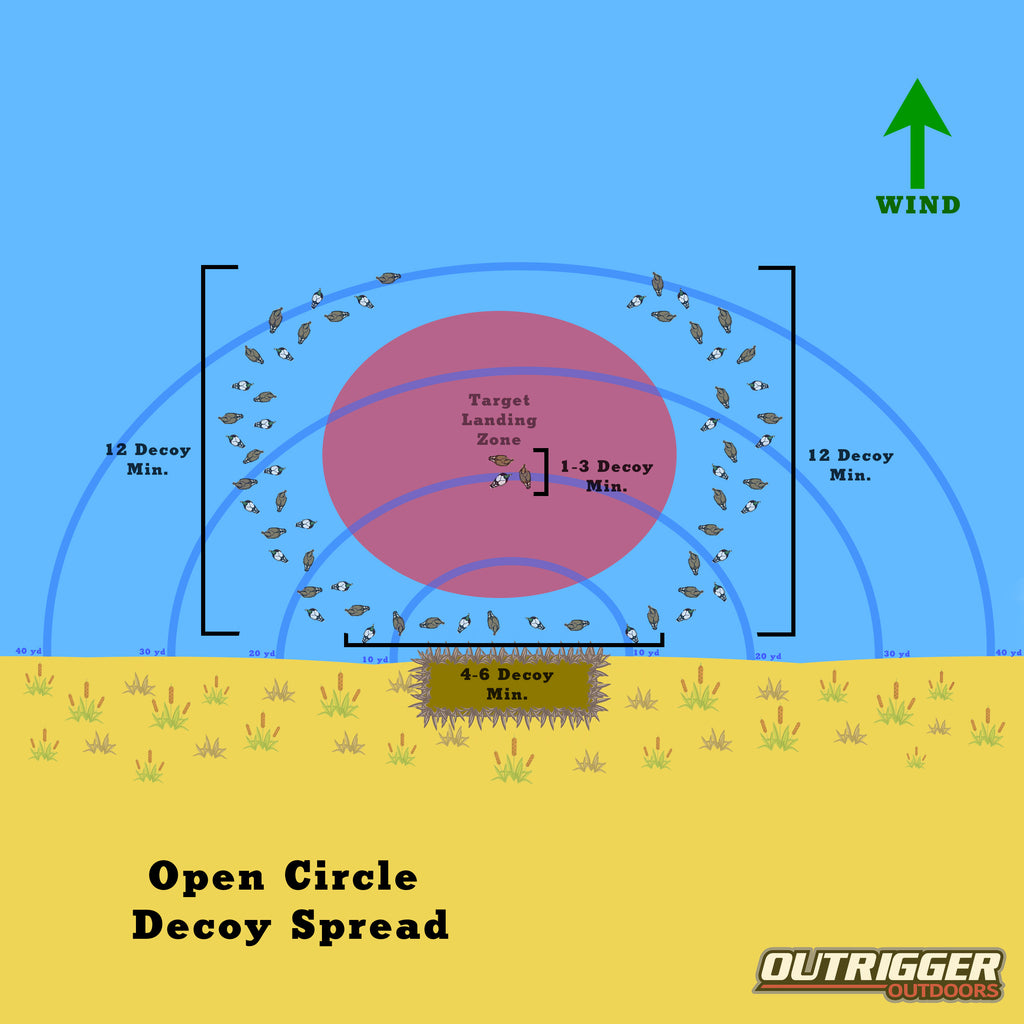
The open circle decoy spread is more inviting to smaller flocks or even one-off ducks traveling overhead. In tight spaces, this spread can be accomplished with 12 decoys, but in more open water scenarios we recommend at least 24-36 decoys. In most universal applications, we recommend abiding by the figure above for the minimums in terms of how many decoys should be spread where.
Types of Decoy Spreads for Highly Pressured Ducks
As the duck hunting season progresses, ducks become more educated and your decoy spread has to adjust accordingly to bring in more gun shy ducks.
J Hook "Fish Hook" Decoy Spread
There are two types of J-hook or "fish hook" decoy spreads. They vary depending on the wind direction: cross wind or wind at your back.
Cross Wind
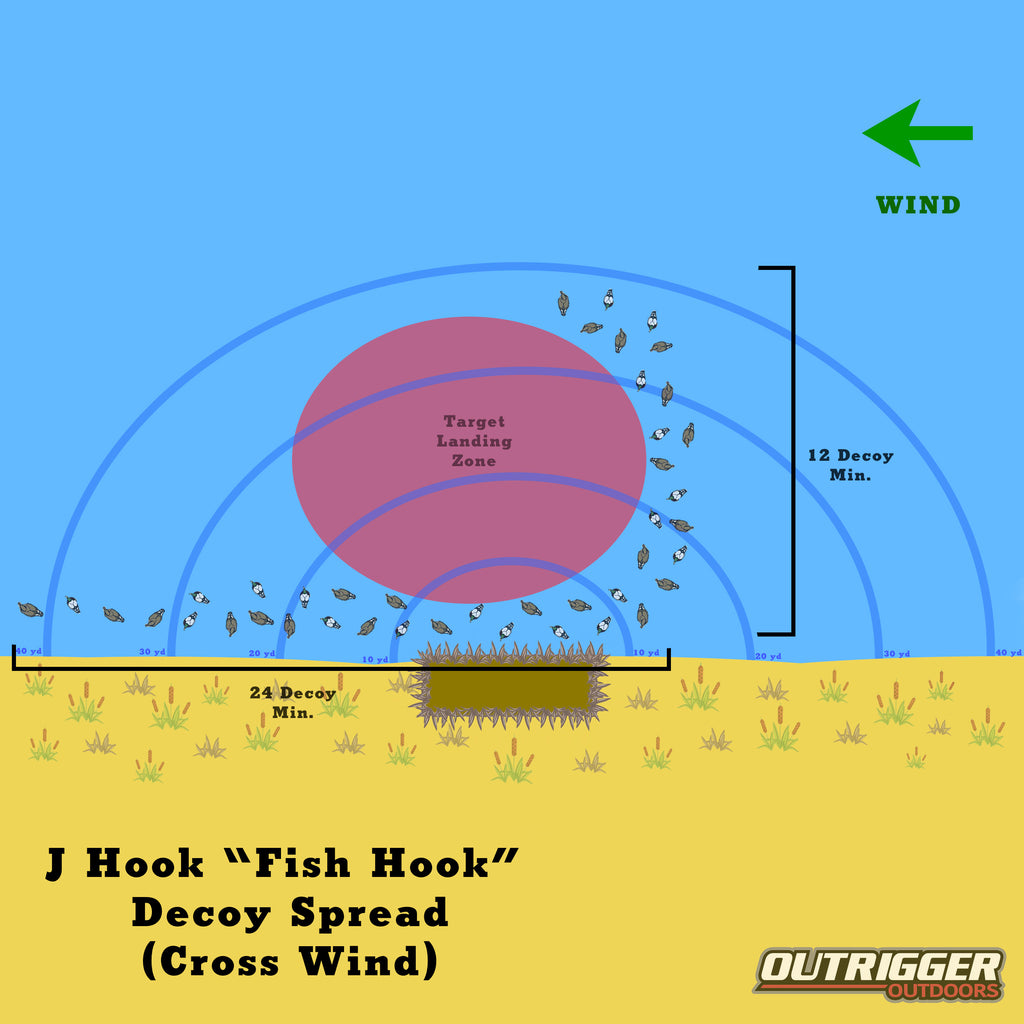
Wind at Back

The J hook decoy spread is ideal for ducks that are a little wary to the conventional spreads most duck hunters deploy. If you have a cross wind, you want to string your decoys out along the bank. As the decoys stray away from your target landing zone, you should lessen the density of decoys. Close to the blind / target landing zone should have the most dense amount of decoys.
Gapped J Hook "Fish Hook" Decoy Spread
The gapped J hook decoy spread is geared towards blind-shy diving-type ducks that have been heavily pressured throughout duck season. This decoy formation is best setup on a cross wind, with your target landing zone being from the shoreline to 30-40 yards off the shoreline. This decoy spread is predominately accomplished on large, open waters.
The theory behind this formation is that the bulk of the ducks are surrounding the blind, eliminating the likelihood ducks land close by and are triggered by seeing the blind. The remainder of the duck decoys are in a straight line heading offshore at roughly a 30 degree angle. You can accomplish the straight line and even 4-5 ft spacing between decoys with trotline rigs. The length of the line should be as long as possible with however many decoys you have, but 40 yards is a good minimum length. You can go as long as 100 yards if you have the decoys to support that.
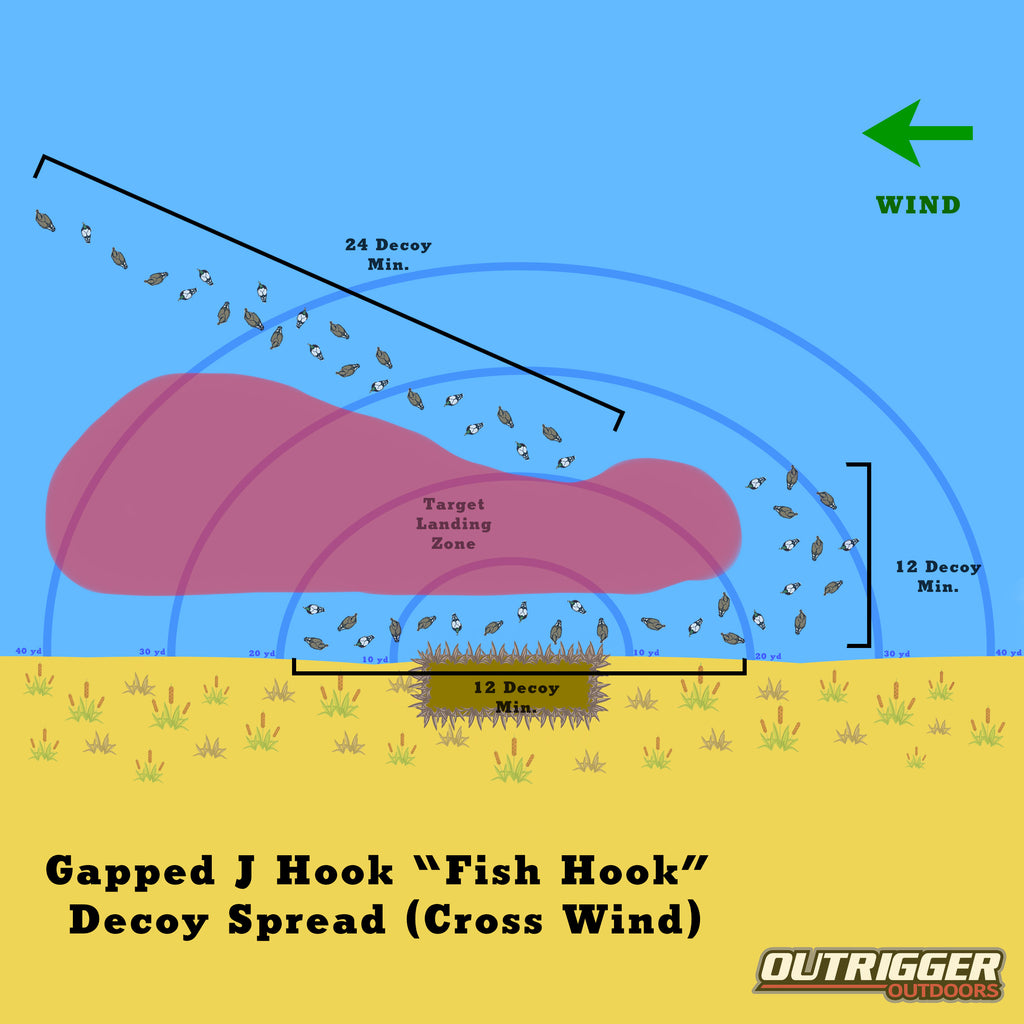
This spread requires the most decoys out of all the spreads. We recommend having at least 4 dozens decoys to properly accomplish this spread.
Passing ducks will locate the end of the straight line of decoys, fly along it until they see the group of decoys gathered, and then land short of the decoy group.
This formation works for shy ducks because you are still controlling where they should land, but you aren't allowing them to get too close to your blind to risk alerting them.
The Wary Duck Side Decoy Spread
Similar to the wary duck split decoy spread, but this time we are positioning ourselves up wind of the decoys. Due to how pressured ducks are, they might come down to see the decoys but never land. The goal here is to be quick on the gun and get them on the way down knowing they aren't here to stay.

We recommend this setup in areas that are heavily pressured from duck hunters on a daily basis.
The Wary Duck Split Decoy Spread
The difference in this split decoy spread and the one we discussed earlier is you are spacing the decoys further away from you. As ducks become more heavily pressured, they grow wary of decoy spreads and are less likely to directly approach them and let within them. However, they are still attracted to them.

The goal is to setup and predict where the ducks are going to fly as they "check out" the decoy spread. They will come down into the wind, and prefer to land a decent distance away from the existing spread, and may only give you a split second of an opportunity for a shot.
